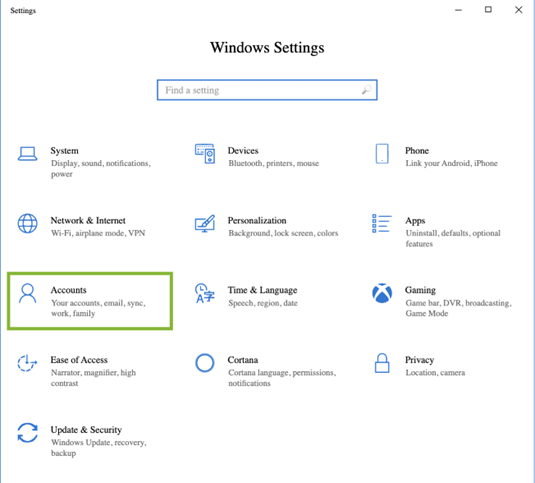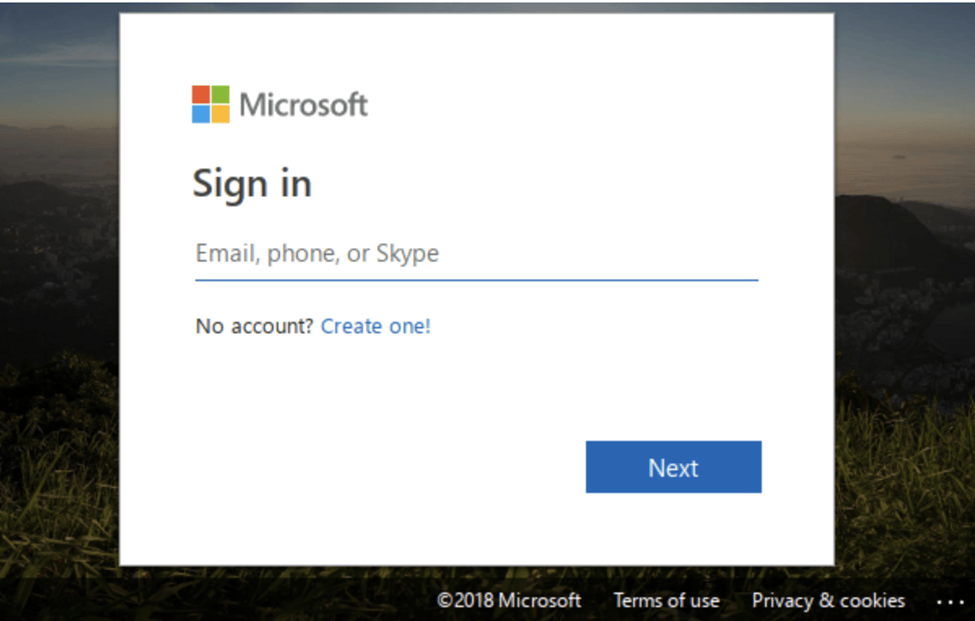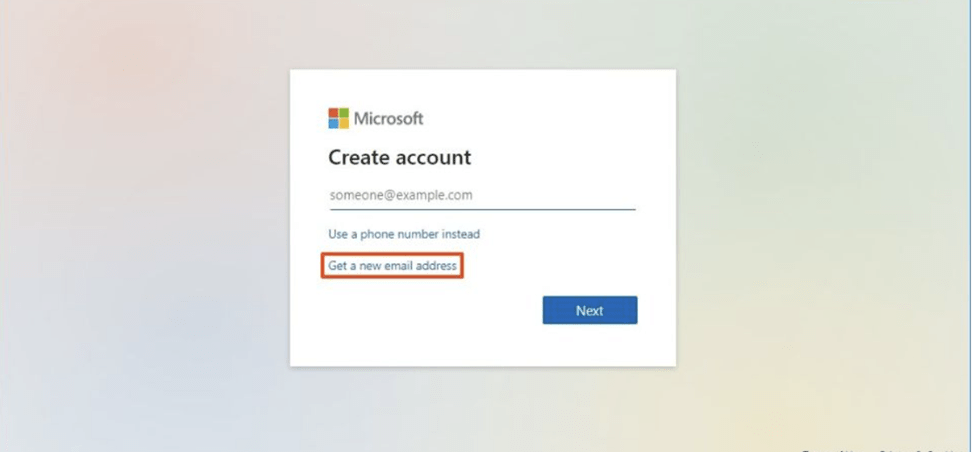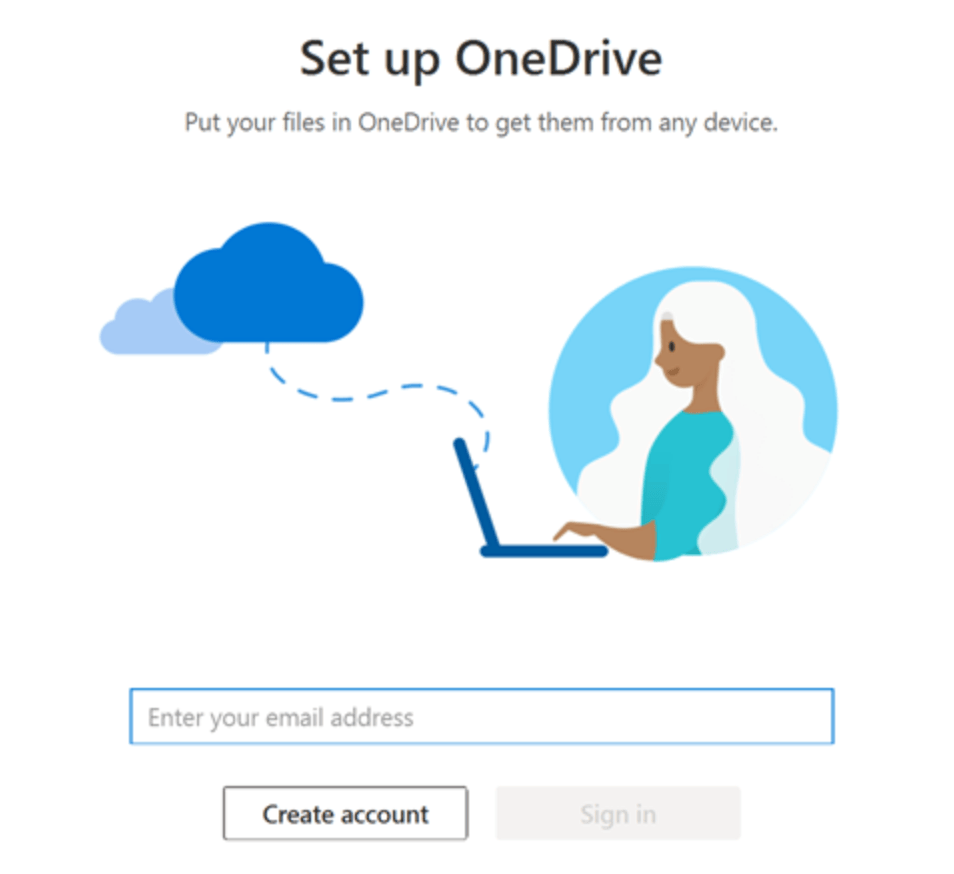How To Set Up OneDrive Cloud Storage
OneDrive is a cloud-based storage service offered by Microsoft. It allows you to store your files online and access them from anywhere. Since it is cloud-based, it is also an excellent way to offload memory space on your hard drive.
However, setting it up may be a bit confusing. In this post, we’ll walk you through the process of setting up OneDrive so that you can start using it as soon as possible.
How to Set Up a OneDrive Cloud Storage Account
The first step in getting started with Microsoft OneDrive is setting up an account. If you use Windows 10, this process is about as straightforward as it can be. You can set it up right from your Accounts tab in Settings.

However, it is just as straightforward on any device and you can do so from the web browser of your choosing.
Let’s take a look at the steps you need to take to get started:
1. Go to the OneDrive website and click Get Started
You’ll be asked to sign in with a Microsoft account through the OneDrive website. If you don’t have one, you can create one by clicking on the Create one! link.

If you create one, you will be able to do so with either an email address or a phone number. Or, you can get a new email address.
If you have an Outlook, Hotmail, or Live email account, you already have a Microsoft account. If you have an Xbox network account, you also already have a Microsoft account.
If you don’t have a OneDrive account already, setting one up is a breeze. Simply use an existing email or phone number to set your account up if you only plan to use OneDrive for cloud storage.

If you want to set up a new email account as well to make things easier, click the Get a new email address option.
Once you are here, enter whatever email address you like in the entry box, then follow the directions that Microsoft prompts you with.
2. Set up OneDrive on your computer
After you create an account and/or sign in, your next step will be to set up OneDrive. If you use Windows 10, this process is usually configured automatically when you set up an account with your system (PC or desktop). However, if you are using a new account or had not set one up previously, you will have to configure it manually. However, it is still an easy process:

- Click Start on the home screen.
- Type in “OneDrive. If you do not find it on the Start menu, that means you may not have it downloaded onto your computer. In this case, use the OneDrive client offline installer to set up OneDrive on your computer.
- Click Sign in. Then confirm your account address and password. Then click Sign in again.
- If you want, you can change the default location your files are backed up to in the bottom left corner of the next screen. However, the default location is safe and usually recommended. If you are happy with this location, click Next.
- Select the folders on your hard drive that you would like to back up, and then hit Continue. If you want your files on your computer (photos, documents, and desktop items) to be synced with OneDrive, leave everything selected.
- Quickly go through the next few pages of prompts by skipping when possible and clicking Next for everything else.
- Click Close once you reach the end and OneDrive will start syncing your files to the cloud.
You can check on the status of this sync by opening OneDrive from your Start menu and clicking the blue or white clouds in the upper-right corner of the window.
3. Use OneDrive on your mobile device (optional)
If you want to access your files while on the go, you can download the OneDrive app for your iOS or Android device.
Once it is installed, open the app and sign in with your Microsoft account information. Then, select what you would like to sync (photos, videos, or both) and click Done.
You can access your files by opening the app and signing in. Then, all of your files will be stored locally on your device and you can view them even if you are not connected to the internet.
To save space on your device, only select the folders that you want to sync. That way, you can have access to all of your OneDrive files without taking up too much space on your phone or tablet.
4. Upload files to OneDrive from your computer
Now that your account is all set up, it is time to start using it!
The first thing you will probably want to do is upload some files. To do this, first open the File Explorer. Then, click the Start menu and then click This PC.
In the left sidebar, you should see an icon for OneDrive. If you do not see this, click View and then select Show hidden files, folders, and drives.
OneDrive will be located under your hard drive(s). Double-click it to open it.

Once you have File Explorer and OneDrive open, drag and drop the files that you want to upload into the OneDrive window. The files will start uploading automatically and you can check their status by looking at the bottom of the window.
If you do not wish to drag and drop, you can also click the Upload button in the upper-right corner of File Explorer and then select the files that you want to upload.
You can also upload files from your mobile device by opening the OneDrive app and signing in. Then, click the plus sign in the bottom-right corner and select Upload photos or videos. Finally, select the files that you want to upload and click Open.
Your files will start uploading automatically and you can check their status by looking at the bottom of the window.
5. Check sync statuses for your desired files
Once you have everything set up, you need to know how to check the status of your files.
There are a few different status symbols. Here is what they mean:
- White cloud with a border: This file is available on the cloud via the internet and is not taking up any space on your computer hard drive.
- White cloud with a blue border and a person: This means that the file is available offline on your computer and is also being synced with OneDrive.
- Cloud with an arrow: This indicates the same thing as the white cloud with a blue border.
- Solid icon with a green checkmark: This means that the file has been completely uploaded to OneDrive from your device.
- White icon with a green checkmark: This file is available offline because it was downloaded from your computer. This is automatic, but you can delete these automatically by choosing ‘Free up space.’
- Two arrows forming a circle: This item is currently syncing from OneDrive.
- Minus sign with a circle around it: Files with this icon will not sync.
- Padlock icon: You or your system administrator has chosen not to sync this file.
- Red X icon: There was a problem with the sync of this file.
Common Problems When Setting Up OneDrive Cloud Storage
When setting up OneDrive cloud storage, there are a few problems that are very common. Here is how to solve them:
OneDrive will not sync with your files
One of the most common problems is that OneDrive will not sync with your files. There are a few things that you can do to try and solve this problem:
- First, make sure that the file is not too large. OneDrive has a limit of 20 GB for .zip files.
- Second, check your internet connection. OneDrive requires a strong and stable internet connection in order to sync properly.
- Third, make sure that you are not trying to sync too many files at once. OneDrive can only handle a certain number of files at a time.
- Fourth, try restarting the OneDrive program and then try syncing again.
If none of these solutions work, then you may need to contact customer support to figure out why OneDrive is not syncing with your files.
Your computer does not display the OneDrive icon
If the OneDrive icon goes missing on your computer, don’t worry; it is easy to get back. All you need to do is change an entry in your registry and you’re all set.

First, open the Run box (Windows + R) and type in “regedit.” Then hit Enter.
When the registry opens, go to HKEY_CURRENT_USER > SOFTWARE > Microsoft > OneDrive.
Once you’re in the OneDrive folder, find the DisableFileSyncNGSC key and double-click on it.
Then, change the Value data to 0 and click OK.
Now restart your computer and you should see the OneDrive icon back on your system tray.
Your account has lost or missing files
If you are missing files from your OneDrive account, there are a few things that you can do to try and recover them.
First, check the Recycle Bin to see if the files were accidentally deleted. If they are in the Recycle Bin, then you can just restore them.
You can also check to see if you have any backups of your OneDrive files. If you do, then you can just restore your account from the backup.
If you still cannot find them, it is best to visit the OneDrive website and search for the files by name.
Unfortunately, if your files are gone forever, they cannot be recovered unless they are backed up to an external hard drive.
Upgrade browser error from using Internet Explorer
This error is less common these days since most people have moved on from using Internet Explorer (especially if you are using Windows 10). However, if you are still using Internet Explorer, then you may get this error when trying to upgrade your OneDrive account.
If you are reading this after June 15, 2022, you will not have this problem at all because Microsoft is retiring Internet Explorer as of that date.
The best way to solve this problem is to simply use a different browser. Microsoft Edge comes with Windows and it works great with OneDrive. Alternatively, you can download Google Chrome or Mozilla Firefox for free.
Once you have a new browser, try upgrading your OneDrive account again and you should not have any problems.
OneDrive is automatically paused on your computer
If you find that OneDrive is automatically pausing on your computer, it could be caused by a few things:
-
- Your computer is in Battery Saver mode. OneDrive is designed to pause when your computer is in Battery Saver mode to save battery life.
- You have an unreliable internet connection. OneDrive will automatically pause if it detects an unreliable internet connection.
- You’re trying to sync too many files at once. OneDrive can only handle a certain number of files at a time, so it will automatically pause if you’re trying to sync too many files at once.
- Your version of OneDrive is outdated.
However, there are a few things that you can do to fix it.
- Make sure that you have the latest version of OneDrive installed. Microsoft regularly releases updates for OneDrive which can help fix bugs and improve performance.
- Try restarting your computer. This can often help clear up any issues that may be causing OneDrive to not work properly.
- Uninstall and reinstall OneDrive. This will often fix any corrupt files that may be causing the problem.
- Check to make sure that your internet connection is strong and stable. OneDrive requires a strong internet connection in order to function properly.
- Make sure that your computer has ample battery to run OneDrive. If your computer is running low on battery, it can cause OneDrive to pause.
You cannot open files in online Microsoft Office apps
Sometimes you may find that you cannot open files in online Microsoft Office apps. This is usually because the file is corrupted or damaged.
There are a few things that you can do to try and fix this:
- Open the file in a different browser. This can often help if the problem is with your browser.
- Try opening the file in a different Microsoft Office app. This can often help if the problem is with the Microsoft Office app that you are using.
- Try opening the file in a different program. This may be the answer if the problem is with the Microsoft Office app itself.
If you still cannot open the file, it is best to contact Microsoft support for assistance.
Final Thoughts
We hope that this article has helped you to understand how to set up OneDrive cloud storage. Microsoft’s OneDrive is a great way to store your files in the cloud and it is very easy to use. However, if you run into any problems, be sure to check out our list of troubleshooting tips.

